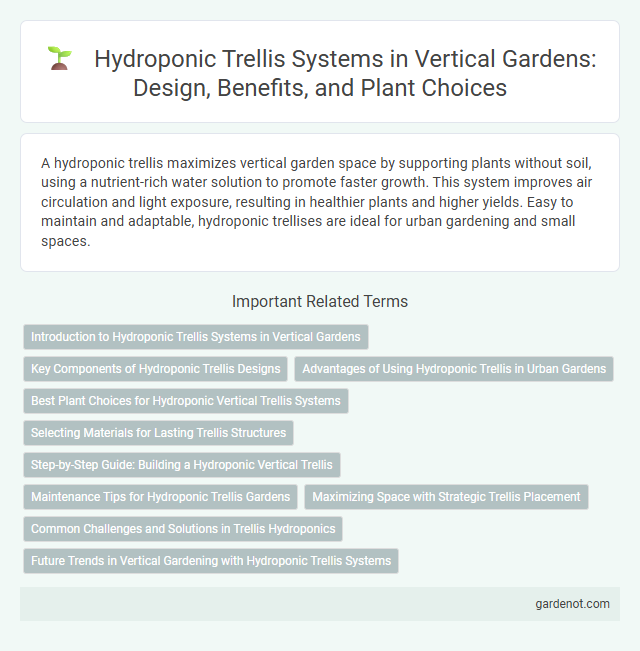A hydroponic trellis maximizes vertical garden space by supporting plants without soil, using a nutrient-rich water solution to promote faster growth. This system improves air circulation and light exposure, resulting in healthier plants and higher yields. Easy to maintain and adaptable, hydroponic trellises are ideal for urban gardening and small spaces.
Introduction to Hydroponic Trellis Systems in Vertical Gardens
Hydroponic trellis systems in vertical gardens optimize space and nutrient delivery by supporting plants without soil, using water-based nutrient solutions to promote faster growth and higher yields. These structures provide vertical support for climbing or vining plants, enhancing air circulation and light exposure to improve photosynthesis efficiency. Integration of hydroponic technology with trellising maximizes plant density and resource use, making it ideal for urban agriculture and indoor farming applications.
Key Components of Hydroponic Trellis Designs
Key components of hydroponic trellis designs include sturdy support structures made from materials such as PVC or metal to anchor the plants securely. The trellis features an efficient water delivery system integrated with nutrient-rich solutions that circulate through channels or pipes, ensuring optimal hydration and nutrient absorption. Durable netting or mesh is essential for guiding plant growth vertically while maximizing space utilization and air circulation.
Advantages of Using Hydroponic Trellis in Urban Gardens
Hydroponic trellises in urban gardens maximize space efficiency by supporting vertical plant growth without soil, allowing higher yields in limited areas. They promote faster plant development and healthier crops through precise nutrient delivery and water management. This system reduces water usage by up to 90% compared to traditional gardening, making it an eco-friendly choice for sustainable urban agriculture.
Best Plant Choices for Hydroponic Vertical Trellis Systems
Tomatoes, cucumbers, and peas are the best plant choices for hydroponic vertical trellis systems due to their natural climbing abilities and high yield potential. Leafy greens like lettuce and spinach also thrive in these systems, benefiting from controlled nutrient delivery and space efficiency. Herbs such as basil, mint, and cilantro adapt well to hydroponic trellises, providing compact growth and enhanced flavor profiles.
Selecting Materials for Lasting Trellis Structures
Selecting durable materials such as galvanized steel or powder-coated aluminum ensures hydroponic trellises withstand moisture and provide long-term support for vertical gardens. UV-resistant coatings prevent material degradation from sun exposure, enhancing structural longevity. Using corrosion-resistant fasteners and modular connectors facilitates easy maintenance and adaptability in hydroponic setups.
Step-by-Step Guide: Building a Hydroponic Vertical Trellis
Constructing a hydroponic vertical trellis begins with selecting a sturdy frame made of metal or PVC pipes to support the weight of plants and nutrient solutions. Install vertical support lines or netting to guide plant growth, ensuring each section receives adequate light and air circulation. Integrate a hydroponic system with a water reservoir, pump, and nutrient delivery pipes to maintain optimal hydration and nutrient supply for efficient vertical gardening.
Maintenance Tips for Hydroponic Trellis Gardens
Regular monitoring of nutrient levels and pH balance is essential for maintaining optimal growth in hydroponic trellis gardens. Keeping the trellis structure clean and inspecting for algae buildup or root diseases prevents system blockages and promotes healthy plant development. Consistent pruning and training of plants on the trellis ensure efficient space utilization and maximize light exposure for higher yields.
Maximizing Space with Strategic Trellis Placement
Hydroponic trellis systems maximize vertical garden space by enabling plants to grow upward, reducing ground footprint while increasing yield per square foot. Strategic trellis placement ensures optimal light exposure and air circulation, promoting healthier plant growth and faster nutrient uptake in hydroponic setups. Utilizing adjustable trellis designs allows customization for various crop types, enhancing space efficiency and boosting overall hydroponic garden productivity.
Common Challenges and Solutions in Trellis Hydroponics
Hydroponic trellis systems often face challenges such as nutrient imbalances, inadequate support for climbing plants, and inconsistent water distribution. To address these issues, regularly monitoring nutrient solution composition ensures optimal plant growth, while using durable, adjustable trellis materials provides stable support. Implementing automated drip irrigation and periodic system cleaning helps maintain consistent hydration and prevents clogging, enhancing overall hydroponic trellis efficiency.
Future Trends in Vertical Gardening with Hydroponic Trellis Systems
Hydroponic trellis systems are revolutionizing vertical gardening by enabling soil-free cultivation with precise nutrient delivery, leading to faster plant growth and higher yields. Future trends indicate integration of IoT sensors for real-time monitoring and automation, optimizing water and nutrient use while reducing waste. Innovative materials and modular designs are enhancing scalability and sustainability, making hydroponic trellises ideal for urban farming and smart agriculture.
Hydroponic trellis Infographic

 gardenot.com
gardenot.com